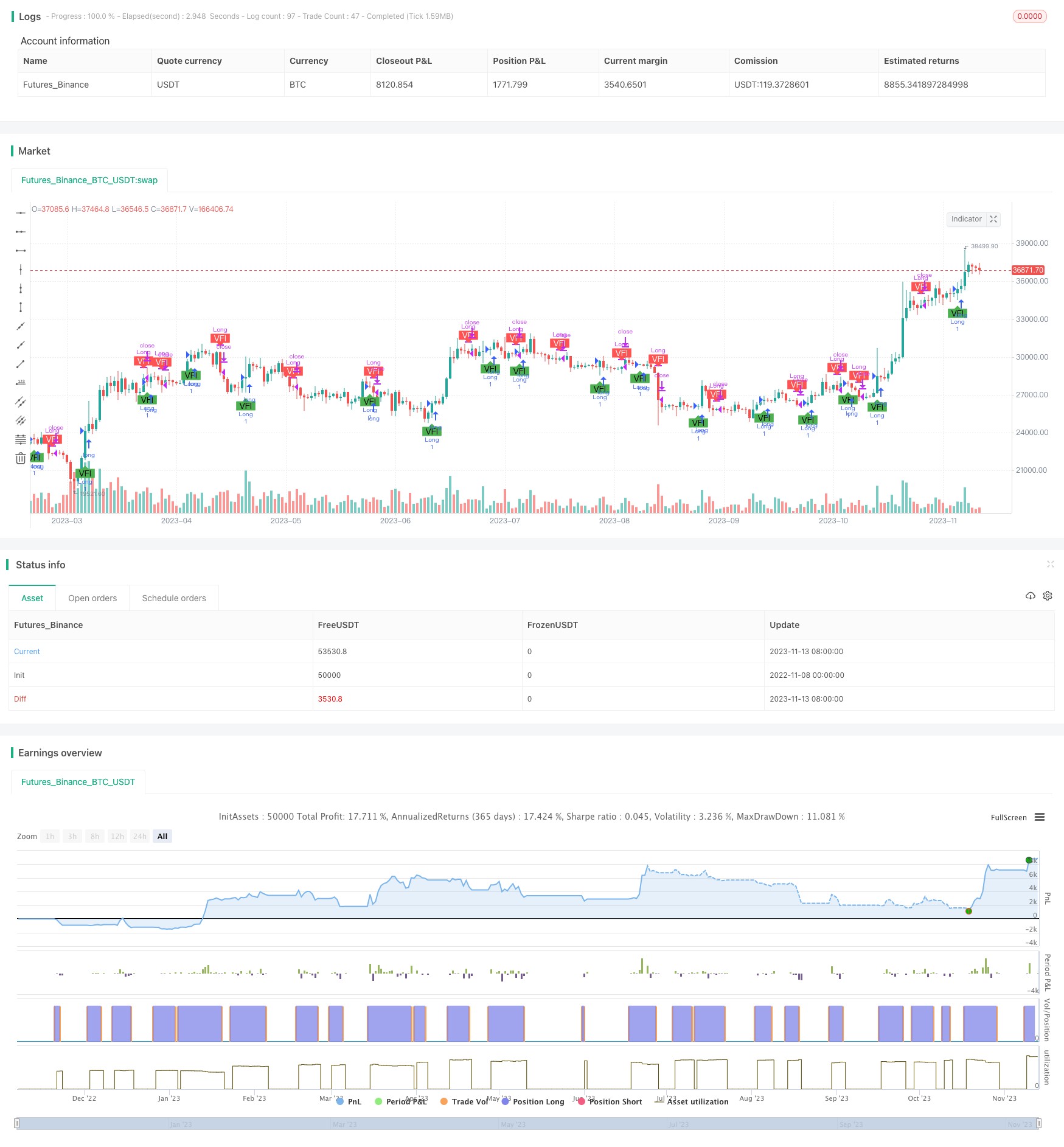
概述
本策略通过计算交易量变化情况,判断市场趋势方向,采用趋势跟踪方式,在趋势开始阶段建立仓位,在趋势结束时平仓止损。
策略原理
- 计算典型价格typical,对数收益率inter,收益率方差vinter
- 计算交易量平均值vave,最大交易量阈值vmax
- 计算价格变化量mf,与方差阈值cutoff比较,计算出价格驱动量vcp
- 汇总vcp得到量价指标vfi,分别计算vfi和其均线vfima
- 比较vfi和vfima大小,得到量价指标差值dVFI,以判定趋势方向
- 当dVFI上穿0时为看涨信号,下穿0时为看跌信号
- 根据dVFI形态,建立做多做空策略
策略优势分析
- 该策略充分考虑了交易量变化对趋势判断的影响,通过动量指标衡量趋势强弱,可以更准确地捕捉趋势转折点。
- 策略加入交易量阈值计算,可以过滤正常波动,只捕捉大资金的集体行为,避免被市场噪音误导。
- 量价联动判断,综合考量价格与成交量,可以有效避免假突破。
- 采用均线过滤和逻辑判断,可以过滤掉大部分假信号。
- 跟踪趋势而非预测反转,非常适合中长线趋势交易,有利于把握市场主要方向。
策略风险分析
- 该策略主要依赖交易量变化来判断趋势,在交易量不活跃的品种中效果会打折扣。
- 交易量数据容易被操纵,可能产生误导性信号,需要防范量价背离的情况。
- 量价关系经常有滞后,可能错过趋势开始的最佳入场时机。
- 粗放的止损方式可能会过早止损,无法持续捕捉趋势。
- 无法有效响应短期调整,对突发事件也可能反应不敏感。
可以考虑加入均线系统、波动率指标等来优化入场和止损;结合更多数据源分析量价关系,防范误导信号;加入适当技术指标提升对短期调整的响应。
策略优化方向
优化入场条件,可以考虑加入均线、자세오극점等判断,在趋势开始后确定入场。
优化止损方式,可以设定移动止损、级别止损等,让止损更贴近价格,跟踪趋势停止。
加入趋势判断环节,如ADX,可以避免横盘和震荡市场的错误交易。
优化参数设置,可以通过更长的数据回测寻找最优参数组合。
将策略扩展到更多品种,寻找质量更好、交易量更活跃的品种。
考虑加入机器学习模型,利用更多数据进行量价关系判断,提升信号质量。
总结
本策略整体思路清晰,核心指标直观易懂,可靠地识别趋势方向。策略优势在于强调交易量变化,适合追踪中长线趋势,但需防范误导信号。通过参数优化、止损方式改进、指标优化组合等方面进行改进,可以进一步增强策略的实盘表现。
策略源码
/*backtest
start: 2022-11-08 00:00:00
end: 2023-11-14 00:00:00
period: 1d
basePeriod: 1h
exchanges: [{"eid":"Futures_Binance","currency":"BTC_USDT"}]
*/
//@version=4
strategy("Strategy for Volume Flow Indicator with alerts and markers on the chart", overlay=true)
// This indicator has been copied form Lazy Bear's code
lengthVFI = 130
coefVFI = 0.2
vcoefVFI = 2.5
signalLength= 5
smoothVFI=true
ma(x,y) => smoothVFI ? sma(x,y) : x
typical=hlc3
inter = log( typical ) - log( typical[1] )
vinter = stdev(inter, 30 )
cutoff = coefVFI * vinter * close
vave = sma( volume, lengthVFI )[1]
vmax = vave * vcoefVFI
vc = iff(volume < vmax, volume, vmax)
mf = typical - typical[1]
vcp = iff( mf > cutoff, vc, iff ( mf < -cutoff, -vc, 0 ) )
vfi = ma(sum( vcp , lengthVFI )/vave, 3)
vfima=ema( vfi, signalLength )
dVFI=vfi-vfima
bullishVFI = dVFI > 0 and dVFI[1] <=0
bearishVFI = dVFI < 0 and dVFI[1] >=0
longCondition = dVFI > 0 and dVFI[1] <=0
shortCondition = dVFI < 0 and dVFI[1] >=0
plotshape(bullishVFI, color=color.green, style=shape.labelup, textcolor=#000000, text="VFI", location=location.belowbar, transp=0)
plotshape(bearishVFI, color=color.red, style=shape.labeldown, textcolor=#ffffff, text="VFI", location=location.abovebar, transp=0)
alertcondition(bullishVFI, title='Bullish - Volume Flow Indicator', message='Bullish - Volume Flow Indicator')
alertcondition(bearishVFI, title='Bearish - Volume Flow Indicator', message='Bearish - Volume Flow Indicator')
if(year > 2018)
strategy.entry("Long", strategy.long, when=dVFI > 0 and dVFI[1] <=0)
if(shortCondition)
strategy.close(id="Long")